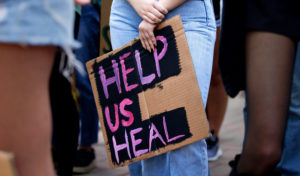As rates of Covid-19 infection started to dwindle, there came signs of a much stranger pandemic: long Covid and its host of long-term complications. You might think that, since men and older people suffer the most complications from the virus, most of those with long Covid would be older men. But this is not so. According to a US Census Bureau survey, women are almost twice as likely as men to report having it, while transgender people are significantly more likely to do so than all other groups. A German study, meanwhile, concluded “there is accumulating evidence that adolescent girls are at particular risk of prolonged symptoms”.
Given that Covid tends to affect men more than women, why would long Covid affect women more than men? And given that Covid complications are extremely rare in the young, why would teenage girls be disproportionately affected by long Covid? Finally, given that we can’t accuse a virus of transphobia, why would long Covid affect transgender people most?
The answer lies in the fact that long Covid is not a strictly physical phenomenon. A study of nearly two million people published in Nature found that people who reported three or more symptoms of long Covid included: 4.9% of people confirmed to have had Covid, and 4% of people with no evidence of having had Covid. So, reporting the symptoms of long Covid is only moderately associated with a prior Covid infection. In fact, long Covid correlates about as much with mood disorders as with Covid itself. One study found that people prone to anxiety and depression before Covid infection were 45% more likely to develop long Covid after infection, and the Nature study found that having anxiety and depression before getting Covid almost doubled the chances of reporting long Covid.
This would help explain why women and trans people are disproportionately reporting long Covid: these two demographics have particularly high rates of anxiety and depression.
But why exactly would mood disorders increase the likelihood of long Covid? Some experts have speculated that stress may affect the immune system’s response to Covid and lead to more serious infections. However, a Turkish study found no evidence that anxiety or depression alters the body’s immune response to the virus. A much likelier explanation could be that, since symptoms of mood disorders overlap with those of long Covid, people are mistaking psychological distress for the side-effects of viral infection.
This is part of a broader phenomenon. Young people are reporting despair and distress at an unprecedented rate, and this mental health crisis is a symptom of a malfunctioning society — a society that is making people sick, by teaching them to feel sick. The tendency for people to misdiagnose their despair as a medical disorder can be observed far beyond reports of long Covid. Consider the surge in cases of gender dysphoria. Between 2012 and 2022, the number of adolescents referred to the NHS’s Gender Identity Development Service (GIDS) increased by over 2000%. If the increase were simply due to decreasing stigma around being trans, it wouldn’t be mostly restricted to a single sex and age range, but it has been driven almost exclusively by young people and natal females.
The group that’s disproportionately reporting gender dysphoria — adolescent girls — appears to be the same demographic as the group deemed in the German study to be disproportionately at risk of long Covid. This is also the group, besides trans people, deemed most at risk of mood disorders. So, again, it seems many young people, particularly girls, are confusing general distress for another illness.
And it’s not just reports of gender dysphoria that have multiplied among young people. Increases have occurred for major depressive disorder, attention-deficit disorder, obsessive-compulsive disorder, social anxiety disorder, generalised anxiety disorder, autism spectrum disorder, and various eating disorders. It seems that young people, and their doctors, are viewing personal issues as medical disorders: we are living through a pathologisation pandemic.
Why are so many people confusing sadness for sickness? It’s human nature to look for single causes to complex problems. The physician’s habit of ascribing all a patient’s symptoms to just one diagnosis led to the formulation of Hickam’s dictum, which states: “A man can have as many diseases as he damn well pleases.” Likewise, it’s tempting to look for a neat and simple reason for people blaming their troubles on a single disorder, but to do this would be to make the same mistake as them. Pathologisation can have as many causes as it damn well pleases.
One may be cyberchondria, the phenomenon whereby people anxiously google symptoms, and, due to confirmation bias, ignore those that don’t apply to them while focusing on those that do, until they become convinced they have the disorder they’re reading about. Another cause may be social contagion, whereby panic spreads through the power of suggestion. According to a UK study, adolescents who reported parents suffering from long Covid were almost twice as likely to report experiencing long Covid symptoms themselves, regardless of whether they’d actually had Covid.
It’s known that social contagions tend to affect girls more than boys, a disparity that could be exacerbated by girls tending to use social media more than boys. But the problem with social contagion as an explanation is that it’s a how, not a why; it offers a means without a motive.
Some have attempted to discern a motive. One is that girls are trying to escape unattainable ideals of femininity. As the arms race of plastic surgery and beauty filters ramps up, natural bodies seem ugly by comparison. This “selfie dysmorphia” may lead to anxiety and depression, as well as symptoms of gender dysphoria, as pubescent girls become desperate to defy the metamorphosis of their bodies into sexual objects. But this explanation doesn’t shed much light on the rise of conditions like long Covid, autism, and obsessive-compulsive disorder. However, a deeper dive into the data does.
When we include politics in the mental health data, it becomes clear that this isn’t simply about gender. A 2020 Pew survey of over 10,000 people found that self-described liberals aged 18-29 were more likely than self-described conservatives of the same age to report suffering psychological problems over the last week. They were also more than twice as likely to say they’d ever been diagnosed with a mental health disorder. Furthermore, those who were “very liberal” were more likely than those who were just “liberal” to report poor mental health. The group most likely to report poor mental health was white liberal females, an alarming 56% of whom reported having received a mental illness diagnosis.
Crucially, controlling for worldview narrowed the gender gap considerably: liberal men were more likely to report poor mental health than conservative women. It would seem, then, that the mental health epidemic among girls and young women is associated with their tendency to have a more Left-liberal mindset than boys and young men — a difference that’s becoming more pronounced over time.
But why would Leftism be associated with poorer mental health? An analysis of data from 86,138 adolescents found, in line with the Pew survey, that between 2005 and 2018 the self-reported mental health of liberals had deteriorated more than conservatives’, and that this deterioration was worst for girls. The researchers blamed this on “alienation within a growing conservative political climate”. However, the New York Times’ Michelle Goldberg debunked this explanation by pointing out that liberals’ mental health woes began while Obama was in power and as the Supreme Court voted to extend gay marriage rights — hardly a conservative political climate.
The real reasons may be deeper. One idea, more than any other, underpins the difference in outlook between liberals and conservatives. Central to Leftism is equality, backed by the idea that people’s fortunes and misfortunes are not their own doing, and therefore undeserved. As such, Leftism de-emphasises the role of human agency in social outcomes, while overemphasising the role of environmental circumstances. As the West has shifted culturally Leftward — due to most writers and artists leaning Left — the depiction of people as hapless puppets has become dominant.
Today’s Left-liberal culture teaches young people that their problems are not their own fault, but rather the product of various systems beyond their control. These systems may be sociological — late capitalism, systemic racism, the patriarchy — but increasingly, they are medical. A common example is “trauma”, a psychiatric term that has become a knee-jerk justification for everything from street crime to silencing opposing views on campus. It’s a word so overused that even clinicians fear it has lost its meaning. Most people, however, are happy to have their personal failings blamed on medical issues, because it absolves them of responsibility. It’s not your fault you violently lashed out, you have trauma. It’s not your fault you lack energy, you have long Covid. It’s not your fault you hate the way you look, you have gender dysphoria.
Pathologisation is also an effective way to manufacture sympathy. The co-founder of Black Lives Matter, Patrisse Cullors, responded to accusations she’d used donation money to enrich friends and family by claiming that the accusations had given her post-traumatic stress disorder, a diagnosis once reserved for rape survivors and war veterans.
Claims like Cullors’s are instinctively met with sympathy and even awe on the Left, where overeager attempts to destigmatise mental illness can end up glamorising it. On social media, young liberals now engage in “sadfishing”, a kind of digital Munchausen’s Syndrome, where people fabricate ailments for pity and clout; some, such as the TikToker “TicsAndRoses”, fake Tourette’s, while others fake multiple personalities. The power of mental health disorders to attract attention online has turned them into fashion accessories, cute quirks to help kids stand out from the crowd, or “part of my dating appeal”.
Unfortunately, these designer disorders are not just harmless labels; intentional pathologisation by influencers is causing unintentional pathologisation among viewers. Reports tell of adolescent girls suddenly developing “TikTok tics” after viewing videos of alleged Tourette’s sufferers. Others tell of adolescents presenting with multiple personalities after watching videos of people claiming to have dissociative identity disorder. As atomisation makes people more desperate for sympathy, and competition makes them more desperate for attention, it’s likely that sadfishing and its consequences will only worsen.
But as disturbing as all this is, victimhood culture is not the only force behind the pathologisation pandemic. It’s been abetted by a medical industry that has its own incentives for exaggerating the prevalence of mental disorders.
Medicalisation — the tendency for clinicians to recategorise ever more things as medical issues — occurs because clinicians are just as human as their patients, and are therefore just as influenced by culture and their own personal biases. The 1973 Rosenhan experiment showed that psychiatrists who have been told that a healthy person is insane will begin to reinterpret that person’s ordinary behaviours, such as note-taking, as manifestations of their mental disorder. We saw this in the Tavistock scandal, where the staff of the infamous Gids clinic, conditioned by ideologues to look for gender dysphoria, became increasingly hasty to diagnose it.
The ability of clinicians to see precisely the symptoms they’re looking for is facilitated by concept creep, the tendency for the definitions of disorders to gradually expand to encompass more people. The rise in autism diagnoses, for instance, can be largely attributed to a diagnostic widening of the autism spectrum. Concept creep occurs largely due to the Shirky principle, which states: “Institutions will try to preserve the problems to which they are the solution.” The motive is often financial; the number of pregnancies deemed to require caesarean sections has increased because this method of delivering babies is more profitable. Likewise, if you’re simply sad then medical companies can’t monetise you, but if your distress is reclassified as, say, gender dysphoria, those companies can sell you puberty blockers or surgical procedures. By 2021, GIDS accounted for a quarter of the Tavistock trust’s income. In the States, the sex reassignment surgery market was valued at $1.9 billion and is projected to have a lucrative annual growth rate of 11.23%.
So, we have a medical industry that is both financially and ideologically motivated to overstate the prevalence of illness, and we have a victimhood culture that encourages people to view themselves as oppressed by things they can’t control. In the middle of this we have ordinary people tempted to blame their problems on medical issues for the sake of easy answers.
These three entities together form a mutually reinforcing system. The late philosopher Ian Hacking, in his book Rewriting the Soul, details how in the 20th century, the press, the public, and the medical industry operated in tandem to create new forms of madness out of mere gossip. Prior to 1970, there were almost no cases of multiple personality disorder (now known as dissociative identity disorder), but after one case was well-publicised by the media, people began using the concept of multiple personalities to make sense of their own problems. In so doing, they began to conform, wittingly or otherwise, to the official symptoms of the disorder. When clinicians speculated that people may invent multiple personalities to deal with childhood sexual abuse, people began to do just that. Some even suddenly “remembered” being sexually abused, even though the concept of repressed memories has no basis in fact. Initially, patients reported having two or three personalities. Within a decade, the average number was 17.
Thus, patient reports influenced clinicians’ diagnoses, but clinicians’ diagnoses also influenced patient reports. Diagnostic criteria became prescriptive as well as descriptive; they told patients how they were supposed to feel and act. Hacking called this cycle of mutual reinforcement a “looping effect”, and it proved so powerful that it turned a couple of isolated cases into an epidemic. A similar looping effect, facilitated by a hyperconnected world, seems to be driving the rise in reports of mental illness today.
This is a problem because imagined sickness can cause real sickness. This occurs in two ways. The first is direct: in rural India, folklore tells that being bitten by a pregnant dog can make one pregnant with the dog’s puppies, and this urban myth has created a new illness: puppy pregnancy syndrome. Victims become so convinced they’re pregnant with puppies that they suffer panic attacks and even manifest symptoms of pregnancy, from persistent nausea to the sensation of puppies crawling in their bellies.
But the second way fake sickness becomes real is far more common and insidious.
Remember how Leftism de-emphasises human agency in the name of equality? Research shows conservatives tend to have an internal locus of control, which means they believe that their decisions, as opposed to external forces, control their destiny. Liberals, meanwhile, tend to have an external locus, which means they believe their lives are determined by forces beyond their control.
The American psychologists Jonathan Haidt and Jean Twenge used national survey data of adolescents to map their locus of control. Their findings were based on the proportion of respondents who agreed with statements such as: “People like me don’t have a chance at a successful life” and “Whenever I try to get ahead, something stops me”. They concluded that, since the Nineties, the locus of control for all teenagers has become more external, but the shift has been greater for liberals, and greatest for liberal girls. Further, when the self-worth of teenagers was mapped, using responses to statements such as “I feel my life is not very useful”, the data showed a universal decline in self-worth since 2012. Again, the decline was stronger for liberals, and strongest for liberal girls.
People with an internal locus of control, believing they control their destiny, tend to be happier and have healthier habits, like good diets and frequent exercise, while people with an external locus of control, believing they’re at the mercy of fate, have higher rates of anxiety and depression and are more likely to abuse drugs and neglect their health. When you believe you have no control, you don’t.
And thus, as society has liberalised, and medicalised, young people have lost both self-belief and resilience. Many have subsequently become trapped in a cycle where they feel distress, and pathologise it, causing more distress, leading to more pathologisation and more distress, which eventually becomes textbook anxiety and depression. The rise in diagnoses is therefore not simply an illusion caused by medicalisation; society is teaching kids to develop real dysfunctions.
This is the greatest danger of the pathologisation pandemic: belief in one’s sickness is self-fulfilling. It’s a disease not of any bodily organ but of hope itself, and it harms its victim by crippling their immunity to everything else.
If there’s a vaccine for the pathologisation pandemic, then the best candidate is Cognitive Behavioural Therapy (CBT). This is a form of talk-based treatment based on the Ancient Greek philosophy of Stoicism. Contrary to modernity, it teaches that our feelings are not always valid, but often deluded and self-destructive. The aim is to reframe harmful thoughts into alternatives that are more accurate, agentic, and soluble. So, instead of “The world sucks”, one could think “I feel like the world sucks right now”. Where pathologisation places problems outside your control, CBT places them within your control. Where pathologisation bundles many small issues into one giant insurmountable problem, CBT breaks down giant problems into small manageable pieces.
No form of psychotherapy has been as rigorously tested as CBT, and its effectiveness in restoring agency and reigniting hope is documented by decades of research. Some studies suggest CBT is gradually losing effectiveness, but this is mostly because CBT, like everything else in the social sciences, has been corrupted by amateurisation and the desire to be “inclusive” and inoffensive. The newest forms of CBT, such as “Transgender-Affirmative CBT”, are the opposite of classic CBT because they seek not to cultivate strength but to validate feelings.
More than ever, a return is needed to the original, Stoicism-based form of CBT, which has helped everyone from the philosopher-emperor Marcus Aurelius, who governed Rome during a time of war and plague, to Vietnam POW James Stockdale, who used it to withstand torture at the notorious “Hanoi Hilton”. The ultimate cure to rampant pathologisation is to prepare the young to do battle against their greatest foe — their own minds — and to teach them a time-tested truth, bequeathed to us by history’s survivors: you are more than the things that happen to you. And you have as much control over your life as you believe you do.
Many of the misfortunes that befall you will not be your fault, but if you seek explanations for your suffering in things beyond your control, you risk falling prey to a culture and industry that are motivated to keep you feeling ill. Look within for the causes and, most times, you’ll find the cures. Modern society will tell you otherwise, of course, but it’s within your power to defy it, for you are not a helpless leaf in the wind but a mind that holds a world, which, depending on how you think, could be a Hell in Heaven, or a Heaven in Hell.
Disclaimer
Some of the posts we share are controversial and we do not necessarily agree with them in the whole extend. Sometimes we agree with the content or part of it but we do not agree with the narration or language. Nevertheless we find them somehow interesting, valuable and/or informative or we share them, because we strongly believe in freedom of speech, free press and journalism. We strongly encourage you to have a critical approach to all the content, do your own research and analysis to build your own opinion.
We would be glad to have your feedback.
Source: UnHerd Read the original article here: https://unherd.com/






